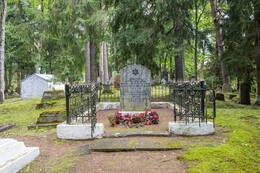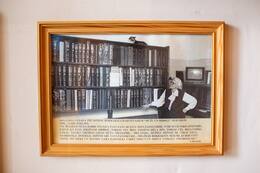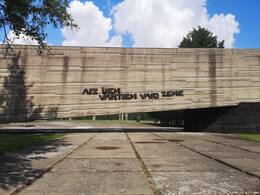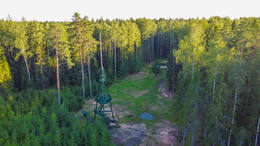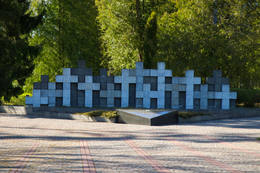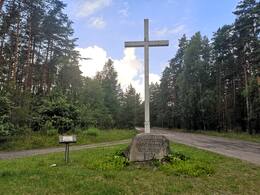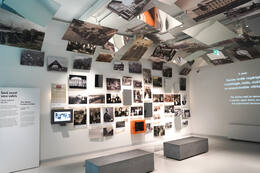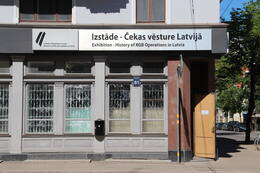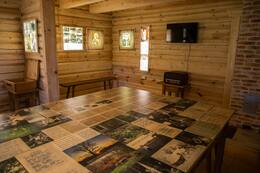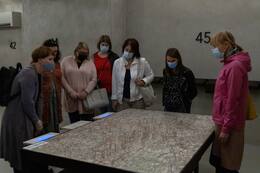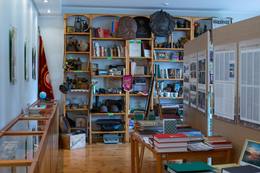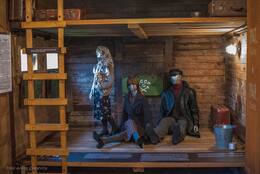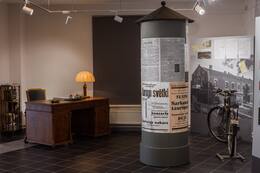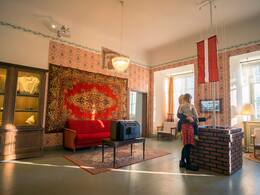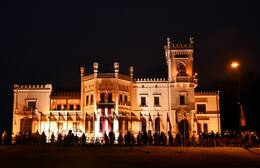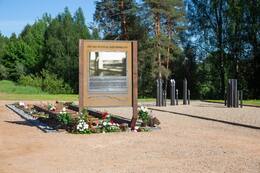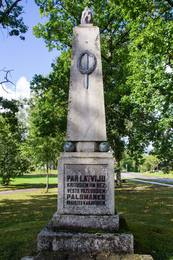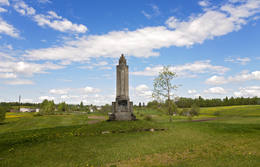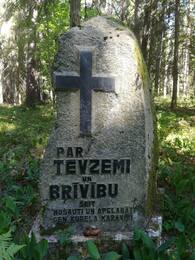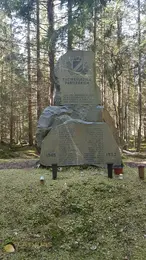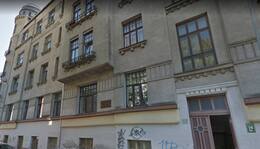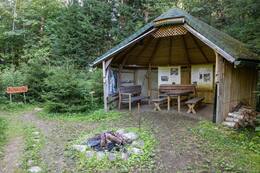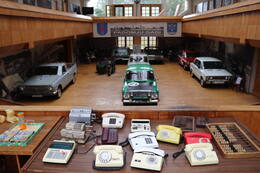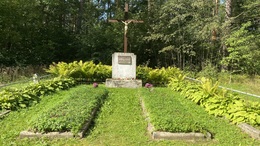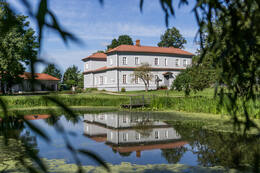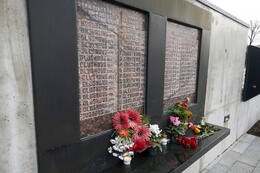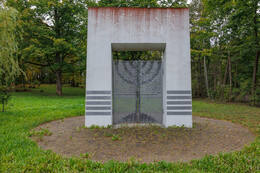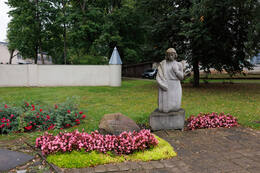Represijos
II Antrasis pasaulinis karas, IV Sovietų okupacija
Represijos – valdžios institucijų naudojamas tam tikrų asmenų ir gyventojų kategorijų persekiojimas, priespauda ir ribojimas. Smurtinės represijos prieš Latvijos gyventojus buvo būdingos tiek SSRS okupaciniams režimams, tiek nacistinės Vokietijos režimams.
Siekdama užkirsti kelią pasipriešinimui ir nepasitenkinimo naujuoju režimu raiškymui, jau 1940 m. vasarą sovietų okupacinė valdžia pradėjo vykdyti sistemingas represijas prieš Latvijos piliečius, kurias vykdė SSRS NKVD (Vidaus reikalų liaudies komisariato) represinės organizacijos ir pagal jų modelį vietoje sukurtos struktūros. Dėl politinių priežasčių 1940–1941 m. buvo suimta daugiau nei 7000 Latvijos gyventojų, neskaičiuojant tremtinių. Didžiausia represinė akcija buvo 1941 m. birželio 14 d. trėmimas, kurio metu iš Latvijos į SSRS gyvuliniais vagonais buvo išvežta 15 424 gyventojų. Suimtieji buvo išsiųsti į GULAG'o pataisos stovyklas, o administracine tvarka ištremtieji – apgyvendinti Sibiro kolūkiuose.
1941 m. vasarą Latvijos teritorija pateko į nacistinės Vokietijos valdžią, kurios okupacinis režimas buvo ne mažiau žiaurus nei sovietinis. Didžiausias nacistinės Vokietijos įvykdytas nusikaltimas Latvijos teritorijoje buvo žydų genocidas, arba Holokaustas. Dėl Hitlerio rasistinės ideologijos buvo sistemingai sunaikinta beveik visa Latvijos žydų bendruomenė, gyvavusi kelis šimtus metų – apie 70 000 žydų ir dar 20 000 žydų iš kitų Rytų Europos teritorijų. Žydų šaudymo kampanijos daugiausia buvo vykdomos jau 1941 m. Vokiečių okupacinis režimas taip pat taikėsi į politinius režimo oponentus ir sovietų aktyvistus, kurie nespėjo evakuotis į Rusiją prasidėjus SSRS ir Vokietijos karui.
Nuo 1944 m. Latvijos teritorijoje buvo įtvirtinta ir atkurta sovietų okupacinė valdžia. Antroji sovietų okupacija atnešė naujų politinių represijų. Pirmaisiais pokario metais Latvijoje veikė ginkluotas nacionalinis pasipriešinimo judėjimas, arba nacionaliniai partizanai. Jų tikslas buvo atkurti Latvijos nepriklausomybę. XX a. 5-ajame dešimtmetyje vyko masiniai šio pasipriešinimo judėjimo dalyvių ir jų rėmėjų areštai, taip pat buvo baudžiami tie Latvijos gyventojai, kurie savanoriškai ar prievarta bendradarbiavo su vokiečių okupaciniu režimu, taip pat kitos gyventojų grupės. 1944–1945 m. buvo suimta apie 38 000 žmonių. Didžiausia baudžiamoji akcija, įvykdyta sovietų okupacijos metu po Antrojo pasaulinio karo, buvo 1949 m. kovo 25 d. trėmimas. Per tą laiką iš Latvijos į Sibirą ir kitas atokias SSRS vietoves buvo deportuoti 42 195 Latvijos gyventojai, daugiausia moterys ir vaikai. Manoma, kad per pirmąją sovietų okupaciją 1940–1941 m. ir 1945–1953 m. Latvijoje per sovietų represijas kentėjo arba žuvo 140–190 000 žmonių.
Baiminantis sovietinio okupacinio režimo sugrįžimo, 1944 m. taip pat prasidėjo pabėgėlių judėjimas iš Latvijos į Vakarus jūros ir sausumos keliais.
Daugiau informacijos šaltinių
Totalitarinių okupacinių režimų represijos prieš Latvijos gyventojus. 1940–1953 m. Latvijos nacionalinis istorijos muziejus: http://lnvm.lv/?page_id=3976
Totalitariniai okupaciniai režimai Latvijoje 1940–1964 m. Latvijos istorikų komisijos tyrimai. Latvijos istorikų komisijos dokumentai. 13 tomas. Ryga, 2004. https://www.president.lv/storage/kcfinder/files/item_1618_Vesturnieku_komisijas_raksti_13_sejums.pdf
Susijusi laiko juosta
Susijusios vietos
Varaklianų žydų kapinės – memorialas vokiečių fašistinio teroro aukoms atminti
Varakļāni žydų kapinės, Kapsētas gatvės gale.
Galima pamatyti du paminklus, kuriuos po karo Varaklianų žydų kapinėse pastatė gyvi giminaičiai ir draugai.
Vienas jų stovi prie kapinių tvoros, kur vyko masinis žydų naikinimas. Ant jo užrašas rusų ir jidiš kalbomis skelbia: „Mes amžinai gedėsime savo tėvų, brolių ir seserų, žuvusių nuo fašistų rankos 1941 m.“ Antrasis paminklas yra kapinių viduje; toje vietoje, kur vėliau buvo perlaidoti nužudyti žydai, ant jo taip pat yra užrašas jidiš ir rusų kalbomis: „Amžina atmintis vokiečių-fašistinio teroro aukoms – Varaklianų žydams, žiauriai nužudytiems 1941 m. rugpjūčio 4 d.“
Nacistinės Vokietijos kariuomenė į Varaklianus įžengė 1941 m. liepos pradžioje ir nuo pat pirmųjų dienų pradėjo žydų ribojimą ir individualias žudynes. Šalia žydų kapinių buvo įkurtas sąlyginis getas, į kurį turėjo persikelti visi žydai. Rugpjūčio 4 d. žydų kapinių teritorijoje vokiečių SD dalinys („Arāja komanda“), padedamas vietos savigynos pajėgų, sušaudė praktiškai visus Varaklianų žydus (apie 540 žmonių).
Kiekvienais metais pirmąjį rugpjūčio sekmadienį Varaklianų žydų kapinėse vyksta atminimo renginys, skirtas Varaklianuose nužudytiems žydams.
Melanijos Vanagos ir Sibiro kasyklos muziejus
Melanijos Vanagos muziejus įsikūręs Amatos kaimo mokykloje, Cėsių savivaldybėje. Muziejuje eksponuojama medžiaga apie rašytojos ir kultūros istorikės Melanijos Vanagos gyvenimą, literatūrinę veiklą, šeimą ir likimą: vaizdo medžiaga apie Sibirą ir ten gyvenančius tremtinius latvius bei Sibiro žeminė, nukelianti lankytojus į rašytojos tremties vietą Tiuchteco rajone, Krasnojarsko srityje. Žeminės išvaizda ir išplanavimas sukuria realistinį gyvenimo toli nuo namų vaizdą. Eminėje eksponuojami unikalūs istoriniai daiktai, atvežti iš Tiuchteto muziejaus: beržo tošies indas, vadinamas „tuesok“, molinis puodelis, vadinamas „krynka“, ir žibalinė lempa. Muziejuje rodomi vaizdo interviu su politiškai represuotais savivaldybės asmenimis ir 18 personažų iš Melanijos Vanagos knygos „Staiga nusikaltėlė: šešiolika metų Sibire“. Muziejaus virtuali paroda „BŪK SAVIMI!“. (http://esipats.lv) pasakojama apie penkių deportuotų vaikų ir jų tėvų, kuriuos sovietų valdžia neteisingai apkaltino „tėvynės išdavyste“, patirtį.
Salaspilio memorialinis ansamblis
Salaspilio memorialas ir istorinė ekspozicija yra Salaspilio savivaldybėje, 1,2 km nuo Rygos–Daugpilio greitkelio A6. Salaspilio memorialas buvo atidengtas 1967 m. toje vietoje, kur Antrojo pasaulinio karo metu buvo įsikūrusi Salaspilio stovykla. Tai vieta, kuri buvo naudojama sovietinei propagandai ir yra apipinta mitais bei pusinėmis tiesomis. Tai geras nacių nusikaltimų ir komunistinės ideologijos, vykdytos kiekvienos okupacijos metu, atvaizdas. Ši represinė stovykla buvo Vokietijos pataisos sistemos dalis. Ji turėjo panašumų su koncentracijos stovyklomis, bet tai nebuvo tas pats. Ji buvo sukurta tam, kad Rygos kalėjimuose nebūtų neproporcingai daug kalinių. Ši stovykla buvo „policijos kalėjimo tęsinys“. Čia buvo kalinami įvairūs žmonės – žydai, Raudonosios armijos karo belaisviai, pravaikštos dalyviai, politiniai kaliniai, nusikaltėliai, prostitutės, Latvijos pasipriešinimo judėjimo nariai, Baltijos šalių kareiviai Vokietijos armijoje ar policijoje ir kiti. Stovykloje galėjo kalėti iki 2200 kalinių. Pagrindinė mirties priežastis (apie 2000 m.) buvo nepakankama mityba, darbo sąlygos, fizinės bausmės ir ligos.
Komunistinio genocido aukų memorialas
Šis memorialas yra Pilistverės kapinėse.
Memorialo pamatai pradėti 1988 m., susirinkus 300 žmonių. Bendros savanorių pastangos tęsiasi iki šiol, memorialas kasmet tobulinamas. Memorialo idėją pasiūlė laisvės kovotoja Lagle Parek.
Jo centre stūkso akmenų krūva, kurią iš Estijos, Sibiro ir dar toliau atgabeno estų emigrantai. Krūsnį vainikuoja didelis kryžius. Kryžiaus papėdėje yra simbolinis kapas, į kurį estai neša akmenis, norėdami pagerbti į Sibirą ištremtų artimųjų atminimą.
Akmenų krūvą supa Aate-Heli Õun suprojektuoti ir etapais įstatyti rieduliai, po vieną kiekvienai apskričiai.
Šalia memorialo yra Endelis Palmiste suprojektuoti atminimo akmenys Černobylio radiacijos aukoms, „Miško broliams“, NKVD darbo kolonose pašauktiesiems, Suomijos armijoje tarnavusiems estų savanoriams ir laisvės kovotojams. Visus juos sukūrė Endelis Palmiste.
Be akmenų krūvos, šalia memorialo pasodinta daugiau nei 2000 medžių giraitė. Giraitę suprojektavo garsus kraštovaizdžio architektas Andresas Levaldas.
Istorinėje Pilistverės klebonijoje, kuri yra pagrindinis memorialinės vietos pastatas, yra archyvas ir Estijos istorijos muziejaus paroda apie Estijos okupaciją.
Latvijos kariuomenės vasaros stovykla Litenėje
Latvijos armijos vasaros stovykla Litenėje įsikūrusi miške, Litenės valsčiuje, netoli Pededzės upės. Litenės stovyklos ištakos siekia 1935 m., kai buvo pradėtas Latvijos armijos Latgalos divizijos vasaros stovyklos komplekso statyba. Nuo gegužės iki rudens Litenėje keli tūkstančiai kareivių mokėsi kovos taktikos ir šaudymo įgūdžių. 1941 m. vasarą Latvijos armijos karininkus Litenės armijos vasaros stovykloje suėmė Raudonosios armijos ir NKVD kariuomenės daliniai. Keletas karininkų buvo sušaudyti vietoje, kiti ištremti į Sibirą. 1941 m. birželio 14 d. mažiausiai 430 karininkų buvo suimti ir ištremti į Sibirą Litenės ir Ostroviečių stovyklose, esančiose maždaug už 10 kilometrų nuo Litenės. Vienintelis išlikęs istorinis stovyklos pastatas yra maisto sandėlis. Iš kitų pastatų išlikę tik pamatai. Yra apžvalgos aikštelė su Latvijos vėliava, suolai ir gerai prižiūrima laužavietė. Gynybos ministerijos ir Nacionalinių ginkluotųjų pajėgų remiant, buvo įrengta demilitarizuota patranka. Pastatyti informaciniai stendai. Su Litenės stovyklos įvykiais taip pat susijęs Skausmo sienos memorialas Litenės kapinėse. Latvijos armijos „YouTube“ kanale yra vaizdo įrašas pavadinimu „Litene, Latvijos armijos Katynė“.
Memorialas „Skausmo siena“
Litenės kapinėse randama meno kūrinių.
2001 m. birželio 14 d. Litenės kapinėse buvo atidengtas architektų Dinos Grūbės, Benitos ir Dainio Bērzinių, akmenkalių Ivaro Feldbergo ir Sandro Skribnovskio sukurtas memorialas „Skausmo siena“. Jis simbolizuoja 1941 m. žuvusių karių poilsio vietą. 1988 m. spalį buvusios Latvijos armijos vasaros stovyklos teritorijoje Sita siloje, Litenės parapijoje, rasti 11 karininkų, kuriuos 1941 m. birželį nužudė sovietų armija, pelenai. Nors jų tapatybės nustatyti nepavyko, 1989 m. gruodžio 2 d., po pašventinimo pamaldose Gulbenės evangelikų liuteronų bažnyčioje, jie buvo iškilmingai perlaidoti Litenės kapinėse.
11 baltų kryžių, atminimo lenta ir informaciniai stendai.
Memorialas „Baltasis kryžius“ Stopiniuose
Įsikūręs miške 50 m nuo V36 greitkelio, atkarpoje nuo Juglos popieriaus fabriko kaimo iki P4 greitkelio.
Nuo 1941 m. vasario 3 d. iki kovo 25 d. šioje vietoje keturiose duobėse buvo palaidoti 23 žmonės. Aukos buvo sušaudytos Čekos pastate Rygoje. Ekshumacija įvyko 1944 m. balandžio 27 d. Tuo metu buvo identifikuoti 14 palaidotųjų, o šiandien, atlikus tyrimus, identifikuoti visi šioje vietoje palaidoti asmenys.
Baltasis kryžius šioje vietoje buvo pastatytas 1991 m. liepos 12 d. kaip komunistinio okupacinio režimo aukų atminimo ženklas. Baltąjį kryžių pagamino ir pastatė Liaudies fronto nariai ir Stopinių rajono gyventojai. 1998 m. prie Baltojo kryžiaus buvo pastatytas skulptoriaus Uldžio Stergio sukurtas atminimo akmuo su užrašu „Rusijos imperializmo aukoms 1941“.
Čia buvo palaidoti: Jānis Bergmanis (1900-1941), Alberts Bļodnieks (1904-1941), Kārlis Goppers (1876-1941), Arveds Laane (1916-1941), Ernests Ošs-Oše (1882-1941), Jān4 Pace1-1, Jā1901-1. (1897-1941), Arnolds Smala (1912-1941), Jāzeps Stoļers (1903-1941), Walfrīds Vanks (1888-1941), Zenons Vjaksa (1904-1941), Viktors Kopilovs (1904-1941), 1 Kār48 5 Artūrs (1904-1941). (1904-1941), Jevgenijus Simonovas (1896-1941), Eduards-Verners Anerauds (1897-1941), Efraims Gorons (1910-1941), Pēteris āaksa-Timinskis (1913-1941), Paļickis Melbārdis (1949) Izraelis (1911-1941), Jānis Priedītis (1897-1941), Jānis-Arnolds Stālmanis (1913-1941), Aleksandrs Weinbergs (1884-1941).
Latvijos okupacijos muziejus
Muziejuje eksponuojama Latvijos istorija nuo 1940 iki 1991 m., nacistinės Vokietijos ir Sovietų Sąjungos okupacijos laikotarpiu. „Ateities namai“ – tai žinomo Amerikos latvių architekto Gunāro Birkertaus suprojektuoto Okupacijos muziejaus rekonstrukcijos ir išplėtimo projektas, taip pat nauja muziejaus ekspozicija. Ekspoziciją „Čekos istorija Latvijoje“ sukūrė Okupacijos muziejus, ji yra buvusiame SSRS Valstybės saugumo komiteto (KGB) pastate „Kampiniame name“. Latvijos okupacijos muziejus buvo įkurtas 1993 m. Jis pasakoja ilgai slėptą Latvijos valstybės, tautos ir žemės likimo istoriją dviejų užsienio totalitarinių valstybių okupacijos laikotarpiu nuo 1940 iki 1991 m. 2020 m. pabaigoje muziejuje buvo daugiau nei 70 000 įvairių istorinių eksponatų (dokumentų, nuotraukų, rašytinių, žodinių ir daiktinių įrodymų, daiktų ir atminimo dovanų). Muziejaus specialistai įrašė daugiau nei 2400 vaizdo įrašų, todėl tai viena didžiausių okupacijos kolekcijų Europoje. Latvijoje, Lietuvoje ir Estijoje klostęsi įvykiai aiškiai parodo, ką tautoms teko ištverti valdant dviem totalitariniams režimams.
Paroda KGB pastate „KGB operacijų Latvijoje istorija“
Buvęs SSRS Valstybės saugumo komiteto (paprastai vadinamas Čeka) pastatas atviras lankytojams. Čia čekistai kalindavo, tardydavo ir žudydavo Latvijos piliečius, kuriuos okupacinis režimas laikė priešininkais. Taip pat eksponuojama Latvijos okupacijos muziejaus ekspozicija apie Čekos veiklą Latvijoje. Siūlomos ekskursijos po kalėjimo kameras, koridorius, rūsį ir kiemą. Namas pastatytas 1911 m. ir yra vienas gražiausių pastatų Rygoje. Liaudyje vadinamas „Kampiniu namu“, jis buvo baisiausias sovietinio okupacinio režimo simbolis Latvijoje ir vienas iš SSRS valdžios ramsčių. Čeka iš Kampinio namo veikė okupacijos metu nuo 1940 iki 1941 m., o vėliau nuo 1945 iki 1991 m. Dešimtys tūkstančių latvių nukentėjo nuo tiesioginio politinio persekiojimo. Kova su sovietų valdžios priešais tęsėsi ir po Antrojo pasaulinio karo. Čekos požiūris į savo veiklą šiek tiek pasikeitė po Stalino mirties. Fizinį kankinimą pakeitė psichologinis teroras. Dauguma Čekos agentų buvo latviai (52 %). Antra pagal dydį grupė buvo rusai – 23,7 %. 60,3 % agentų nebuvo Komunistų partijos nariai. 26,9 % agentų turėjo aukštąjį išsilavinimą. Sistema buvo sukurta taip, kad įtrauktų vietos gyventojus ir taip turėtų didesnę kontrolę visuomenėje. Personalo dokumentai ir tarnybos įrašai yra Rusijoje. Ši medžiaga nebuvo prieinama Latvijos valdžios institucijoms ir tyrėjams.
Bronislavos Martuževos poezijos klėtelė
Bronislavos Martuževos muziejus įsikūręs poetės vaikystės namų vietoje Indranų valsčiuje, Maduonos savivaldybėje. Muziejaus ekspozicija įrengta renovuotame tvarte, kuriame eksponuojami balso ir vaizdo įrašai iš Nacionalinio pasipriešinimo judėjimo, poetės darbo leidžiant pogrindinį žurnalą, taip pat kuriant eilėraščius ir dainas nacionaliniams partizanams. Bronislava Martuževa dalyvavo pasipriešinimo judėjime nuo pat jo įkūrimo. Lazdinės, Martuževos namai, kurie neišliko, taip pat buvo prieglobstis Latvijos nacionalinių partizanų asociacijos vadovui Pēteriui Supei ir jo bendražygiams. Poetė penkerius metus slapstėsi savo namų rūsyje, susitikinėjo su partizanais, rašė eilėraščius (įskaitant kūrinius, skirtus partizanams Pēteriui Supei, Viliui Tomui, Smilgos grupei, Laiveniekui, Salnui, Celmiņui, Bruno Dundurui ir kitiems), taip pat rašė dainas ir mokė jų partizanus. Dabar jos dainas dainuoja grupė „Baltie lāči“ (pažodžiui: „Baltieji lokiai“). 1950 m. kartu su Viliu Tomu pogrindyje buvo leidžiamas žurnalas „Dzimtene“ (pažodžiui: „Tėvynė“). Poetas ranka perrašė 11 žurnalo numerių, po 10 egzempliorių. Poetė, jos brolis, sesuo, motina ir Vilis Tomas buvo suimti 1951 m. Bronislava Martuževa iš Sibiro grįžo 1956 m. Pripažintas vietos ir šalies mastu, poezijos tvartą lanko tiek vietos gyventojai, tiek savivaldybės svečiai. Susipažinimas su poetės gyvenimu suteikia galimybę atrasti Latvijos likimą.
Istorinė ekspozicija „Deganti sąžinė“
Istorinė ekspozicija „Sąžinės ugnis“ yra Cėsyje, netoli Cėsių pilies aikštės. Įkurta sovietmečio laikinojo sulaikymo įstaigoje, ji pasakoja apie Latvijos okupaciją ir atskleidžia stebinančias bei didvyriškas asmenų pasipriešinimo istorijas. Kieme yra memorialinė siena su 643 buvusio Cėsių rajono gyventojų, žuvusių per sovietų represijas, vardais, įskaitant 1941 ir 1949 m. deportuotus nacionalinius partizanus bei sušaudytus ir mirties bausme nuteistus asmenis. Parodos laiko juosta skatina lankytojus susipažinti su Latvijos okupacijos eiga nuo 1939 iki 1957 m. Pagal temas išdėstytos citatos iš vietinių laikraščių siūlo palyginti dviejų okupacinių režimų politinę propagandą. Šešios laikinojo sulaikymo kameros išliko iki šių dienų originalia forma nuo 1940 iki 1941 m. ir pokario metais. Čia Cėsių rajono gyventojai, sulaikyti už įvairią antisovietinę veiklą, įskaitant nacionalinius partizanus, jų rėmėjus, antisovietinius lankstinukus platinusį jaunimą ir kitus „tėvynės išdavikus“, pirminio tyrimo ir tardymo metu buvo laikomi kelias dienas, o vėliau išsiųsti į pagrindinį KGB pastatą Rygoje. Viskas čia tikra: kameros su geležinėmis durimis, įmontuotos „kormuškos“ (mažos angos maistui), medinės lovos, tualetas sulaikytiesiems, maža virtuvėlė su orkaite, taip pat tipiški sovietmečio aliejiniai dažai ant sienų. 2019 m. paroda užėmė trečiąją vietą nacionaliniame dizaino konkurse – Latvijos metų dizaino apdovanojime.
Vaidavos parapijos kraštotyros nuolatinė ekspozicija
Įsikūręs Vaidavos kultūros ir amatų centre.
Eksponuojama paroda, skirta 1949 m. trėmimų atminimui, taip pat Vajdaviečių dalyvavimui Rygos barikadose 1991 m. sausį. Parodoje taip pat eksponuojami pasaulinių karų įrodymai (daugiausia spausdinta medžiaga).
Gamtos ir istorijos objektai, dvarai, švietimo istorija, kultūra, žymūs žmonės, kolūkio laikų medžiaga, namų apyvokos rakandai, banknotai, laikraščiai, žurnalai apie Vaidavos parapiją.
Komunistinio teroro aukų atminimo vieta Jaunraunos valsčiuje
Įsikūręs „Baižėnuose“, Priekulių valsčiuje
Represuotųjų atminimo vieta įkurta „Baižēnių“ namo tvarto griuvėsių vietoje, kur 1949 m. kovo 25 d. naktį buvo laikomi 40 Jaunraunos parapijos gyventojų, kad ryte jų kelias vestų toliau į Lodės geležinkelio stotį ir Sibirą.
Tarp represuotųjų buvo vaikai iki 1 metų ir 87 metų amžiaus.
Atminimo lentoje taip pat įrašyti sušaudytųjų ar žuvusiųjų tremtyje vardai. Netoliese yra atminimo akmenys Lačplėšio karo ordino kavalieriams.
Trėmimams naudotas galvijinis vagonas – muziejus Skrundos geležinkelio stotyje
1941 m. birželio ir 1949 m. kovo mėn. trėmimams atminti Skrundos geležinkelio stotyje pastatytas atminimo akmuo ir keturašis vagonas, kuris taip pat tarnauja kaip trėmimams skirtas muziejus. Tai pirmasis vagono tipo muziejus Latvijoje, kuriame nuolat eksponuojamos iš Skrundos stoties ištremtų žmonių nuotraukos, laiškai, atsiminimai, dokumentai ir įvairūs daiktai. Skrundos stotis buvo tremtinių surinkimo vieta ir viena iš trijų regiono stočių, į kurią buvo atvežti žmonės iš Skrundos ir Kuldygos apylinkių. 1941 m. iš čia į Krasnojarsko kraštą Sibire buvo ištremta pirmojo atkurtos Latvijos Respublikos prezidento Gunčio Ulmanio šeima.
Deportacijų pagalba sovietai susidorojo su nacionalinių partizanų šalininkais ir tuo pačiu metu baugino likusius kaimo gyventojus, versdami juos stoti į kolūkius.
Paroda „Latvijos armija Pliavinėse XX amžiuje“.
Adresas: Odzienas g. 2, Pļavinės.
Eksponuojama nuolatinė ekspozicija „Latvijos armija Pliavinėse XX amžiuje“.
Pastatas Pliavinėse, Odzienos gatvėje 2, turi ilgą istoriją – nuo tada, kai „Stukmaņi“ didmenininkas „Hugo Apeltofts“ pradėjo jame aktyvią ūkinę veiklą ir taip prisidėjo prie Pliavinių miesto plėtros, iki to momento, kai Nepriklausomybės karo metu čia buvo įkurtas Latvijos Rytų fronto štabas. 1919 m. būtent iš Pliavinių buvo vadovaujamos Latvijos armijos dalinių operacijos prieš Raudonąją armiją Latgaloje.
1934 m. prie šių namų buvo atidengta memorialinė lenta su užrašu: „1919 m. šiuose namuose buvo įsikūręs Rytų fronto štabas, o čia generolas Janis Balodis perėmė vyriausiąją Latvijos nacionalinės armijos vadovybę.“ Sovietų valdžia ją 1940 m. pašalino ir sunaikino, tačiau 1990 m. birželio 16 d., padedant Latvijos nacionalinės išlaisvinimo armijos Pliavinės skyriui, ji buvo atstatyta.
Dabar šalia buvusio štabo pastato stovi memorialinė stela, skirta 15 Lačplėsio Karo ordino riterių, gimusių Pliavinos krašte, o patalpose sukurta paroda „Latvijos armija Pliavinoje XX amžiuje“, kurioje pasakojama apie Laisvės kovų įvykius, Latvijos armijos 3-iosios Latgalos divizijos štabo veiklą Pliavinoje, taip pat galima susipažinti su Lačplėsio Karo ordino riterių gyvenimo istorijomis.
Netoli parodų pastato yra Latgalos divizijos štabo pastatas, kurį 1913 m. kaip „Stukmanu“ likerio fabriką pastatė grafas Teodoras Medemas. 1919 m. jį perėmė P. Stučkos režimas, kuriame taip pat buvo įkurtas kalėjimas. Išvijus bolševikus, 1925 m. pastatą perėmė Latvijos armija, kurioje buvo įsikūręs Latgalos divizijos štabas. Šiame pastate savo karinę karjerą praleido 10 Latvijos armijos generolų ir kitų karininkų. 1940 m. pastatą perėmė Raudonoji armija. Pokario metais jame buvo įsikūrusi mokykla, taip pat savivaldybė. Apie 1970 m. pastatą pradėjo naudoti gamybos susivienijimas „Rīgas Apērbs“.
Parodą būtina apžiūrėti iš anksto telefonu 28442692.
Paroda „Kovos už laisvę XX amžiuje“ Jėkabpilio istorijos muziejuje
Įsikūręs Krustpilio pilyje
Paroda „Kovos už laisvę XX amžiuje“
Sovietinės represijos. Sunkūs prisiminimai. Sėdėdami čia, klubo kėdėje, turite galimybę pasiklausyti Jėkabpilio gyventojo Ilmāro Knagio knygos „Buvo tokie laikai“ ištraukų. Ant vienos iš kambario sienų bejausmiškai, tarsi titrai po filmo, slenka į Sibirą ištremtų piliečių sąrašas. Ten pat, sename televizoriuje, galite žiūrėti mėgėjišką vaizdo įrašą apie Lenino paminklo pašalinimą Jėkabpilyje. Lankytojus domina ne tik turinys, bet ir techninės galimybės – kaip šis filmas buvo sukurtas sename televizoriuje.
Jekabpilio istorijos muziejuje galima pasiklausyti muziejaus specialistų parengtų paskaitų arba užsiregistruoti į ekskursiją: Jekabpilis ir jo apylinkės Pirmojo pasaulinio karo metu, Jekabpilis 1990 m., Barikadų metas, 1949 m. trėmimai – 70, Jėkabpiliečiai – Lačplėšio karo ordino kavalieriai ir kt.
Vidutinė paskaitų trukmė – 40 minučių. Informacijos ir registracijos į paskaitas teirautis telefonu 65221042, 27008136.
Jekabpilio istorijos muziejus įsikūręs Krustpilio pilyje. 1940 m., Latviją prijungus prie SSRS, Krustpilio pilyje buvo dislokuota 126-oji šaulių divizija. Antrojo pasaulinio karo metu pilyje buvo įsikūrusi vokiečių ligoninė, o po 1944 m. rugpjūčio mėn. – Raudonosios armijos karo ligoninė. Po karo Krustpilio pilyje ir gretimuose dvaro pastatuose buvo įsikūrę 16-ojo tolimojo nuotolio žvalgybos aviacijos pulko ir 15-osios sovietinės armijos oro armijos centriniai sandėliai.
Alūksnės muziejus
Alūksnės muziejus įsikūręs nacionalinės reikšmės architektūros paminkle – neogotikinėje Alūksnės Naujojoje pilyje, pastatytoje XIX a. pabaigoje. Muziejuje veikia paroda „Totalitarinio režimo aukų memorialinis kambarys“, kurioje pasakojama apie Alūksnės savivaldybės gyventojų likimus Sibire ir Tolimuosiuose Rytuose, o laikotarpis nuo priešistorės iki šių dienų susitinka Alūksnės istorijos ekspozicijoje „Amžių šventė“. Joje yra atskiras skyrius, skirtas 7-ojo Siguldos pėstininkų pulko indėliui į kariuomenę, kultūrą ir visuomenės gyvenimą. 7-ojo Siguldos pėstininkų pulko formavimas prasidėjo 1919 m. birželio 20 d. Naukšėnų dvare. Iš pradžių iš Šiaurės Latvijos brigados rezervinio bataliono buvo suformuota 22 karininkų ir 1580 kareivių kovinė grupė, pavadinta Dankersų divizija. Ji buvo įtraukta į 3-iojo Jelgavos pulko 2-ąjį batalioną. Rugpjūčio 23 d., padidėjus kuopų skaičiui, jis tapo 7-ojo Siguldos pėstininkų pulko dalimi. Dalyvavęs mūšiuose prieš Bermontą, 1920 m. sausio 5 d. pulkas buvo perkeltas į Latgalos frontą kovoti su bolševikais. Pasirašius taikos sutartį su Sovietų Rusija, pulkas saugojo rytinę Latvijos sieną. Latvijos nepriklausomybės kare žuvo daugiau nei 200 pulko karių, o 85 buvo apdovanoti Lačplėšio karo ordinu. 1921 m. 7-asis Siguldos pėstininkų pulkas buvo dislokuotas Alūksnėje. Pulko štabas buvo įsikūręs Alūksnės naujojoje pilyje. Po Antrojo pasaulinio karo pilį perėmė sovietų saugumo institucijos. Nuo šeštojo dešimtmečio pabaigos pilyje buvo įsikūrusios įvairios kultūros įstaigos: Vykdomojo komiteto Kultūros ir kinematografijos skyrius, pionierių namai, biblioteka, kino teatras ir muziejus.
Tremtinių atminimo ženklas Amata stotyje – ešelonas Nr. 97322
Įsikūręs Drabešių valsčiuje, Amatos rajone, netoli buvusios Amatos stoties pastato.
Galima aplankyti tremtinių atminimo vietą su informaciniu stendu ir aikšte.
Iš viso 1949 m. kovo 25 d. ir vėlesnėmis dienomis iš Latvijos 33 ešelonais buvo deportuota daugiau nei 42 tūkst. žmonių.
1949 m. kovo 27 d., antrą valandą nakties, iš Amata stoties išvyko 62 vagonai – ilgasis ešelonas Nr. 97322 su 329 vyrais, 596 moterimis ir 393 vaikais.
Centrinis objektas bus 1318 įvairių dydžių ir spalvų metalinių stulpų. Kiekvienas iš jų simbolizuoja asmenį, deportuotą iš tuometinių Cėsių ir Alūksnės apskričių 1949 m. kovo 25 d. Ant kiekvieno stulpo įrašytas tremtinio vardas, pavardė, gimimo metai ir parapija – iš kurios vietos jis buvo ištremtas. Šiuo metu pačių tremtinių arba jų giminaičių parama įrengta 394 stulpai, o dar reikia 932 stulpų.
Idėjos autorius Pēteris Ozols taip pat turi savo rubriką, bet vis dar su tuometine pavarde – Ozoliņš, kuris būdamas šešerių metų su šeima 1949 m. kovo 26 d. buvo atvežtas iš Kosos parapijos į „Pērkoņiem“.
Informaciniame stende pateikiama informacija apie 1949 m. trėmimą ir SSRS represinių organų okupuotose Baltijos šalyse vykdytą operaciją „Priboi“ (Krantės banga), kuri buvo trėmimo pagrindas.
Paminklai pasauliniuose karuose žuvusiems ir ištremtiems Palsmanės parapijos gyventojams
Įsikūręs netoli Palsmanės liuteronų bažnyčios.
Lankytini paminklai – žuvusiems ir dingusiems be žinios Latvijos Nepriklausomybės kare, žuvusiems ir dingusiems be žinios Antrajame pasauliniame kare bei paminklas Palsmanės parapijos gyventojams, ištremtiems 1949 m.
Paminklas Palsmanės parapijos gyventojams, žuvusiems Latvijos Nepriklausomybės kare ir dingusiems be žinios, buvo atidengtas 1927 m. Jį atidengė generolas Eduardas Aire (1876–1933).
Lėšas paminklo sukūrimui paaukojo Palsmanės, Meros ir Rauzos parapijų asociacijos ir visuomeninės organizacijos.
Dailonio Breikšo vadovaujamų nacionalinių partizanų atminimo vieta „Daiņkalni“
Įsikūręs „Daiņkalni“ gyvenvietėje, Raunos valsčiuje, Raunos rajone (šalia „Mežvijų“ namų Smiltenės rajone, Brančių valsčiuje).
Patekti į memorialinę vietą galima tik kartą per metus – balandžio 16 d.! Kelias veda per privačią valdą.
Atminimo vieta įkurta buvusių „Daiņkalni“ ir „Graškalni“ namų vietoje Raunos valsčiuje, kurių bunkeriuose nuo 1950 iki 1952 m. slapstėsi Dailonio Breikšo (slapyvardis Edgaras, 1911–1952) vadovaujama nacionalinių partizanų grupė. D. Breikšo nacionalinių partizanų grupė buvo įkurta 1948 m. ir iki 1950 m. jie gyveno Gatartos valsčiaus „Jaunvieslavene“ pas savo dvarininką Kārlį Lačį. 1950 m. D. Breikšo partizanų grupę išdavė jo paties brolis Laimonis, todėl jie buvo priversti persikelti. Vasaromis jie gyveno miškuose, o žiemas leisdavo Raunos valsčiaus „Daiņkalni“ pas miškininką Artūrą Pērkoną (1907–1952) ir bunkeriuose, pastatytuose po namais netoliese esančiuose „Graškalni“.
Nuo 2002 m. memorialinė vieta „Daiņkalnuose“ buvo palaipsniui tvarkoma. Kiekvienais metais balandžio 16 d. rengiami atminimo renginiai Dailonio Breikšo vadovaujamiems nacionaliniams partizanams atminti. 2003 ir 2004 m. balandžio mėn. prie „Daiņkalnų“ ir „Graškalnų“ namų buvo atidengti atminimo kryžiai ir lentos. 2016 m. rudenį – 2017 m. pavasarį, padedant vietos Raunės gyventojams, memorialinė vieta buvo rekonstruota pagal architekto Z. Butano eskizus, o buvusio bunkerio vieta buvo iškasta ir sutvirtinta.
Paminklas Drustų parapijos narių, žuvusių Pirmajame pasauliniame kare ir Latvijos išsivadavimo kovoje, atminimui
Įsikūręs netoli Drustų liuteronų bažnyčios.
Paminklas buvo atidengtas 1932 m. birželio 19 d.
1931 m. birželio 14 d. buvo padėtas paminklo kertinis akmuo, ant kurio išgraviruotas tekstas „Šimtai metų ateis ir išeis, didvyriai aukosis už tėvynę“. Po juo buvo įmūryta cinkuotos skardos kapsulė su atminimo užrašu, kurį pasirašė tuometinis armijos štabo viršininkas generolas Aleksandras Kalejus, žuvusių karių tėvai ir kiti ceremonijos garbės svečiai.
Komunistinės okupacijos metu tekstas po reljefu buvo užcementuotas, tačiau bronzinę lentą parapijiečiai paslėpė. Prasidėjus Atbudimui, vietos Latvijos liaudies fronto aktyvistai nuvalė užrašą ir padėjo išsaugotą lentą jo vietoje.
Nustatyti 41 Drustų parapijos nario, žuvusio Pirmajame pasauliniame kare ir Latvijos nepriklausomybės kare, tapatybės.
Bažnyčios sienos nišose įrengtos komunistinio teroro aukų atminimo lentos – ąžuole iškalti 58 drusteniečių ir gatartiečių vardai – tų, kurių kapai nežinomi.
Paminklas sušaudytiems leitenanto R. Rubenio bataliono kariams
Rubenio bataliono karių kapinės yra Kuldygos–Sabilės kelyje, priešais vietą, kur anksčiau buvo Rendos daktaro disertacija. Prie kelio yra rodyklė, o vos už kelių šimtų metrų nuo kelio – paminklinis akmuo.
Leitenanto Roberto Rubenio batalionas buvo viena iš generolo Jānio Kurelio suformuoto karinio dalinio dalių, kuris nepasidavė vokiečių kariuomenei ir demonstravo aršų vokiečių pasipriešinimą. Usmos laikotarpiu bataliono skaitinė sudėtis išaugo iki 650 vyrų, jame buvo keturios pilnai įrengtos kuopos, greitoji medicinos pagalba ir ūkio komanda. Vadovaujantis štabas: leitenantas R. Rubenis, leitenantas Filipsons, eilinis A. Druviņš, eilinis Šulcs, eilinis Briedis, eilinis seržantas J. Rubenis, eilinis J. Bergs, eilinis Jaunzems.
1944 m. lapkričio 14–gruodžio 9 d. Ugalės, Usmos, Rendos ir Zlėkų valsčiuose vyko įnirtingi mūšiai tarp policijos generolo Friedricho Jekelno vadovaujamų Vokietijos 16-osios armijos, SD ir SS dalinių dalių ir leitenanto Roberto Rubenio vadovaujamo Kurelių dalinio atskiro bataliono. Mūšiuose prie Rendos ir Zlėkų žuvo apie 250 vokiečių kareivių, o Rubenio pulkas patyrė apie 50 aukų.
Po leitenanto Rubenio mirties Druvinšas savo vyrams paskelbė, kad nuo šiol veiks savanoriškai, todėl kelios dešimtys vyrų nusprendė atsiskirti nuo Rubenio bataliono. 1944 m. lapkričio 20–21 d. vokiečių SD dalinys sugavo 11 žmonių grupę ir po tardymo nuvežė į vietinį mišką bei sušaudė.
Nacionalinių partizanų brolių „Dzelzkalni“ kapas
Kapinėse pastatytas paminklas tautinių partizanų atminimui. Akmenyje iškalti Puzės-Piltenės partizanų grupėje tarnavusių partizanų vardai. Paminklo papėdėje esančioje granito plokštėje iškalti metų skaičiai (1945–1953) ir 36 žuvusių partizanų vardai.
1946 m. vasario 23 d. Tārgalės valsčiuje netoli Vārnuvalko įvyko kruvinas mūšis tarp Latvijos nacionalinių partizanų grupės, vadovaujamos vado Brīvnieka, jų stovyklavietėje ir sovietų okupacinės armijos naikintojų dalinio. Mūšyje žuvo šeši partizanai, kuriuos vietos gyventojai slapta palaidojo ten esančiame miške. Vėliau ten pat be teismo ar nuosprendžio buvo palaidoti dar du sušaudyti partizanai. Vietinių gyventojų šis miško kampelis buvo vadinamas Dzelzkalno kapinėmis, kurias daugelį metų galėjo rasti tik žinovai – pagal kryžiaus ženklą eglėje.
1989 m. vasarą Latvijos nacionalinio išlaisvinimo armijos (LNNK) Ugālės skyriaus nariai padėjo beržinius kryžius Puzės-Piltenės grupės, žuvusių 1946 m. vasario 23 d., nacionalinėje laidojimo vietoje Zūrių miško Dzelzkalnių vietovėje ir ieškojo žuvusiųjų giminaičių Latvijoje ir užsienyje.
1991 m. balandžio 27 d., dalyvaujant žuvusiųjų artimiesiems ir kelių šalių nacionalinių organizacijų atstovams, kapus pašventino teologijos profesorius Roberts Akmentiņš, ir jie buvo pavadinti Dzelzkalnų brolių kapais.
Liepojos policijos pastatas arba „Mėlynasis stebuklas“
Liepojoje komunistinio okupacinio režimo įstaiga – milicija – buvo įsikūrusi Respublikos gatvėje 19 esančiame pastate, kurį liepojiškiai nuo pat jo pastatymo XX a. pradžioje vadino „Mėlynuoju stebuklu“. Tuo tarpu Čekos būstinė buvo įsikūrusi Tomos gatvėje 19. Netrukus po okupacijos ji įgijo socialinį pavadinimą „Raudonasis stebuklas“.
Tiriant iki šiol įvykdytus komunistinio režimo nusikaltimus, nustatyta, kad nei Liepojos Čekos pastate, t. y. „Raudonajame stebukle“, nei kalėjime nebuvo vykdomos jokios egzekucijos ar neteisminiai egzekucijos. Visi sulaikytieji, kurie buvo šiose vietose dėl karo veiksmų pradžios Latvijos teritorijoje nuo 1941 m. birželio 23 d., buvo perkelti į Rusijos kalėjimus. Tai paveikė tiek sulaikytuosius, kurie buvo suimti už vadinamuosius „politinius“ nusikaltimus, tiek kriminalinius nusikaltėlius, neatsižvelgiant į tai, ar asmuo buvo tiriamas, ar jau buvo nuteistas.
Kalinių perkėlimas buvo nustatytas SSRS valstybės saugumo liaudies komisaro Vsevolodo Merkulovo 1941 m. birželio 23 d. įsakymu Nr. 2455/M, adresuotu Latvijos SSR, Estijos SSR ir kelių Ukrainos SSR sričių NKGB vadovams. Sušaudymo priežastis buvo siaubinga ir tragiška – kalinių nebebuvo galima perkelti į Rusiją, bet nebuvo leista palikti jų gyvų. Dėl to karo metu Liepojoje taip pat vyko neteisminiai gyventojų sušaudymai, panašiai kaip Rygos centriniame kalėjime, Valmieros kalėjime, Valkos ir Rėzeknės milicijose bei Greizā kalne netoli Ludzos. Minėtas nusikaltimas įvyko „Mėlynajame stebukle“ – Liepojos milicijos pastate, Respublikos gatvėje 19.
Nacionalinių partizanų bunkeris – Miško broliai
Miško brolių bunkeris yra prie Rygos–Pskovo (A2) greitkelio, 76 kilometrus nuo Rygos ir 11 kilometrų nuo Cėsių. Latvijos nacionaliniai partizanai arba miško broliai buvo nedidelės, ginkluotos vietos gyventojų grupuotės, kurios nuo 1944 iki 1956 metų Latvijos teritorijoje kovojo savarankiškai prieš SSRS okupacinį režimą. Miškuose buvo priversti slėptis žmonės, kurie negalėjo arba nenorėjo gyventi Sovietų Sąjungoje. Iš viso Latvijoje veikė apie 20 193 miško broliai. Bunkeris buvo suformuotas remiantis buvusių miško brolių pasakojimais ir prisiminimais apie gyvenimą miškuose, slapstymąsi ir kovą už nepriklausomą Latvijos valstybę po 1945 metų. Bunkeryje eksponuojami ginkluotė ir namų apyvokos daiktai. Eksponuojami partizanų asmeniniai daiktai, ginklai ir nuotraukos. Gido pasakojimą papildo vaizdo įrašas iš interviu su miško broliais. Prie bunkerio yra vieta piknikui. Galima iš anksto užsisakyti ant laužo paruoštos sriubos arba mėgautis vakaru po atviru dangumi žiūrimu kino teatru prie laužo.
Aizkrauklės istorijos ir meno muziejaus ekspozicija „Sovietmetis“
Minint Latvijos šimtmetį, 2018 m. lapkritį Aizkrauklės seniūnijos kultūros namuose pradėjo veikti Aizkrauklės istorijos ir meno muziejaus ekspozicija „Sovietmetis“ – didžiausia ekspozicija Baltijos šalyse, skirta XX amžiaus (1950–1980 m.) kultūriniam ir istoriniam paveldui. Ekspozicija išdėstyta per tris aukštus ir užima 1060 m2 plotą. Joje pristatomi įvairūs gyvenimo sovietmečiu aspektai: buitis, darbas ir laisvalaikis, švietimas ir kultūra. Pirmajame aukšte eksponuojami sovietmečio automobiliai. Atskirai įrengta biblioteka – Raudonasis kampelis. Įvairialypė ekspozicija kviečia susipažinti su sovietmečio kasdienybe ir butų interjeru – baldais, buities reikmenimis, indais, tekstilės gaminiais ir elektros prietaisais.
Kitos ekspozicijos erdvės skirtos emigracijai, sovietinių laikų represijoms, kasdieniam gyvenimui, medicinai, valstybės institucijoms, turizmui ir sportui, vaikystei bei švietimui. Galima apžiūrėti SSRS karinę atributiką ir uniformas.
Atminimo vieta sušautiems pacientams Agluonos katalikų gimnazijos psichiatrijos ligoninėje
Atminimo vieta netoli Agluonos katalikų gimnazijos, kur 1941 m. rugpjūčio 22 d. naciai sušaudė 544 Daugpilio psichiatrijos ligoninės pacientus ir 48 vaikus iš Gryvos vaikų namų. Visi jie buvo perkelti iš Daugpilio į Agluoną, kur iki nužudymo buvo apgyvendinti katalikų gimnazijos patalpose. Sušaudyti buvo užkasti dviejose duobėse.
Šią žmogžudystę, kaip ir žydų žudynes apylinkėse, savo pamoksluose viešai pasmerkė Agluonos dekanas kunigas Aloisas Brockas (1898–1943). Dėl šios priežasties nacių valdžia jį suėmė 1941 m. gruodžio 30 d. Po trijų mėnesių A. Brockas buvo paleistas, bet vėl suimtas 1942 m. gegužės 25 d. A. Brockas mirė 1944 m. balandžio 28 d. koncentracijos stovykloje Noiengamėje (Vokietija) arba Mauthauzene (Austrija).
Atminimo vietoje yra keli antkapiai ir Krucifiksas su atminimo lenta latvių ir rusų kalbomis.
Paroda „Ludzos kraštas 1918–1945. Tegyvena Latvija amžinai!“ Ludzos kraštotyros muziejuje
Ludzos kraštotyros muziejaus paroda „Tegyvena amžinai Latvijoje! 1918–1945“ atspindi svarbų istorinį Rytų Latgalos vystymosi etapą nuo 1918 iki 1945 m. Parodoje eksponuojami įvairūs šio istorinio laikotarpio relikvijos. Tarp jų – daiktai, kurie kadaise priklausė ludziečių gyventojui ir Laisvės kovų dalyviui R. Kalniniui. Erdvės meninis apipavidalinimas leidžia lankytojams pajusti to meto atmosferą, kai Latviją užliejo masinių trėmimų banga. Centrinė relikvija, vaizduojanti šį istorinį etapą, yra medinis kryžius, kurį pagamino represuotas katalikų kunigas Kazimiras Vitanis. Antrojo pasaulinio karo mūšio lauko instaliacija sukuria emociškai ryškią to meto atmosferą. Parodos lankytojai taip pat gali susipažinti su sovietų ir vokiečių armijų karo apdovanojimais. Parodoje eksponuojamos senos Ludzos nuotraukos suteikia lankytojams supratimą apie miesto vaizdą prieš ir po Antrojo pasaulinio karo.
Audrinių kaimo aukų memorialas
Atminimo lenta buvusiame Rėzeknės kalėjime, atidengta 1965 m. Skirta trisdešimčiai vyrų iš Audrinių kaimo, Makašenų valsčiaus, kurie buvo viešai sušaudyti šioje vietoje 1942 m. sausio 4 d. Lentoje iškalti 30 sušaudytų vyrų vardai.
Netrukus prieš tai buvo išsiaiškinta, kad Audrinių kaime slapstosi pabėgę Raudonosios armijos karo belaisviai. Per ginkluotus susirėmimus, kilusius jų suėmimo metu, žuvo 4 pagalbinės policijos pareigūnai. Nacių okupacinė valdžia, keršydama už įvykį, įsakė nužudyti visus Audrinių gyventojus ir sudeginti kaimą. Vieša egzekucija Rėzeknėje buvo keršto kampanijos dalis.
Holokausto memorialas
2004 m. rugpjūtį Preilių mieste, Cēsų gatvėje, atidarytas Holokausto memorialas. Architektas buvo Sergejus Rižas, o idėjos autorius ir finansuotojas – vietos gyventojas Davidas Zilbermanis, gyvenantis Jungtinėse Valstijose. Memorialas yra teritorijoje tarp žydų piliečių kapų ir žydų gyventojų šaudymo duobių.
Pirmieji žydai į Preilius atvyko XIX a. pradžioje, kai pradėjo formuotis Preilių miestas. Remiantis 1935 m. surašymu, iš 1662 Preilių gyventojų 847 (51 %) buvo žydai. Dauguma jų buvo pirkliai, amatininkai, taip pat inteligentija – gydytojai ir mokytojai.
Kai 1941 m. liepos 28 d. įžengė Vokietijos nacių armija, rugpjūčio 9 ir 10 d. buvo sunaikinta daugiau nei 720 Preilių ir apylinkių žydų. Po karo dalis žydų grįžo į Preilius, tačiau bendruomenė niekada nebuvo atkurta.
2013 ir 2014 metais Vokietijos jaunimo asociacijos LOT studentai ir jos vadovas Klausas Peteris Rexas atliko žydų piliečių kapinių tvarkymo ir paminklų valymo darbus. Buvo sudarytas kapinių žemėlapis. 2015 metais Davido Zilbermanio iniciatyva, jo lėšomis ir aukomis, Preilių žydų bendruomenei, prie įėjimo į žydų piliečių kapines, pakeliui į Holokausto memorialą, buvo atidaryta memorialinė arka.
2018 m. Preilių memorialinė draugija (pirmininkas Sergejus Rižas) atliko kasinėjimus žydų žudymo vietoje šalia žydų piliečių kapinių. Buvo aptiktos trys duobės. Po konservavimo materialinius įrodymus galima apžiūrėti pagrindinėje Preilių istorijos ir taikomosios dailės muziejaus ekspozicijoje, Rainio bulvare 28. Muziejaus specialistai lankytojams siūlo edukacinę programą „Mąstyti apie Holokaustą reiškia galvoti apie save“. Programa prasideda muziejaus ekspozicijoje ir baigiasi Holokausto aukų memoriale. Memorialas kartu su kapinėmis naudojamas visuomenės švietimui kaip muziejus po atviru dangumi.
Paminklas politiškai represuotiems ir nacionaliniams partizanams Preiliuose
Preilių politiškai represuotųjų paminklas yra aikštėje prie Romos katalikų bažnyčios vartų ir buvo atidengtas 1993 m. rugpjūčio 22 d. Paminklą sukūrė skulptorė Vija Dzintare. Paminkle pavaizduota gedinti moteris, klūpanti ir užklojanti mirusįjį antklode. Šalia paminklo esančiame akmenyje iškalti poeto Kārlio Skalbės žodžiai:
Buvo išrinkta daug kankinių
Tau, mano mažoji Tėvyne,
Kas kartu su motinos vardu yra šventas
Skausmo valandą sušnabždėk: „Latvija!“
Kadangi būtent šioje vietoje XX a. 5-ajame dešimtmetyje sovietų okupacinė valdžia viešai apžiūrai eksponavo sušaudytų nacionalinių partizanų palaikus, siekdama įbauginti gyventojus, memorialinė vieta 2018 m. buvo papildyta. Šalia paminklo pastatyti du rieduliai, simbolizuojantys nacionalinių partizanų atminimą. Riedulius sukūrė skulptorius Ivo Folkmanis. Ant vieno iš jų išgraviruotas Preilių politiškai represuotųjų draugijos „Likimo kelias“ logotipas, o ant kito – užrašas „Žuvusių Nacionalinio pasipriešinimo judėjimo narių atminimui“.
Kiekvienais metais kovo 25 ir birželio 14 dienomis čia vyksta politinių represijų aukų atminimo pamaldos.
Susijusi istorija
Apie generolą Karlį Goppersą
Generolas K. Goppersas (1876–1941) buvo iškilus kareivis ir iškili asmenybė. Jis pasižymėjo kaip sėkmingas vadas, vadovavęs batalionams ir pulkams, didvyriškai vadovavęs savo šauliams kovose už Latvijos laisvę Pirmojo pasaulinio karo (1914–1919 m.) metu. Jis dalyvavo mūšiuose prie Tyreļpurvos, Ložmetējkalno ir ginant Rygą.
Generolo Janio Baložo gyvenimas po grįžimo iš tremties
Kai 1940 m. rusai bandė išspausti iš Latvijos vyriausybės palankią karinės bazės sutartį, kuri būtų beveik neįmanomą Latvijos armijos gebėjimą pasipriešinti Raudonajai armijai, generolas J. Balodis bandė gauti kai kurias sutarties pataisas. Tačiau tai nepavyko. Tačiau generolo priešininkai pasinaudojo šia aplinkybe, kad vėliau J. Balodį paverstų beveik išdaviku. Po konflikto su ministru pirmininku ir valstybės ministru K. Ulmaniu generolas 1940 m. balandžio 5 d. buvo atleistas iš karo ministro pareigų. Tuomet J. Balodis nusprendė dalyvauti Saeimos rinkimuose iš Demokratinio bloko, tačiau nieko iš to neišėjo, nes rinkimuose buvo leista dalyvauti tik vienam sąrašui – komunistų kandidatų sąrašui. Latvija tapo 14-ąja sovietine respublika.
Dėl Latvijos okupacijos
1940 m. nepriklausomos Latvijos valstybės egzistavimą nutraukė Sovietų Sąjungos okupacija ir aneksija, arba inkorporacija, į Sovietų Socialistinių Respublikų Sąjungą (SSRS).
Apie vaikų kolonijos „Rūķīši“ įvykius prieškario ir Antrojo pasaulinio karo laikotarpiais
Vaikai buvo atimti iš partizanų rėmėjų šeimų. 1943 m. kovo mėn. Salaspilio stovykloje buvo 1100 vaikų. Apie 250 vaikų mirė nuo tymų, vidurių šiltinės ir kitų ligų, keli šimtai vaikų buvo perkelti į aplinkinių parapijų ūkius, o apie 300 vaikų atsidūrė vaikų namuose Rygos Jūrmaloje, Igatėje ir Saulkrastuose.
Saulkrastuose vaikai atsidūrė Latvijos vaikų pagalbos draugijos vaikų kolonijoje „Rūķīši“.
19-ojo artilerijos pulko vado kapitono Janio Ozolo sugebėjimai 3-iojo Kuršo mūšio metu
Kapitonas Jānis Ozols buvo Latvijos karininkas, Antrojo pasaulinio karo dalyvis, Trijų žvaigždžių ordino riteris, kurio artilerijos divizija neleido pralaužti fronto per Trečiąjį Kuršo mūšį.
Regiono tyrėjas Žanis Skudra nuteistas 10 metų kalėjimo už „Okupuotos Latvijos dienoraštį“
Žanis Skudra visą laisvalaikį skiria vietos istorijai, visas atostogas – kelionėms po Latviją. Taip jis kaupė medžiagą, fotografavo ir sukūrė „Okupuotos Latvijos dienų knygą“, kurią leidžia Latvijos nacionalinis fondas Stokholme, pasivadinęs Jāniu Dzintarsu.
1978 m. birželio 7 d. Žani Skudra buvo suimtas Taline, o tų pačių metų lapkritį Rygos Aukščiausiasis Teismas jam skyrė dvylikos metų laisvės atėmimo bausmę už išdavystę ir šnipinėjimą.
Buvusio legiono leitenanto - čekų agento Arvīdo Gailīčio vaidmuo likviduojant Pēterio Čeverso grupuotę
Kapitonas Pēteris Čeversas ir dar septyni partizanai buvo sugauti 1950 m. lapkričio 1 d. Engurės miškų masyve, kur, visiškai atsitiktinai, netoliese buvo dislokuota netikra partizanų grupė, vadovaujama buvusio Legiono leitenanto Arvydo Gailīčio (agento-kovotojo slapyvardis „Grosbergas“). Joje buvo Latvijos SSR VDM operatyvininkų ir agentų-kovotojų, apsimetusių „miško broliais“.
Peterio Cheeverso grupės veikla ir sunaikinimo istorija
P. Čeversas aplink save subūrė buvusius legiono karininkus, taip pat priėmė į grupę Kuržemės gyventojus. Visi jie pasirinko likti ištikimi laisvos ir nepriklausomos Latvijos valstybės idėjai, o ne pasiduoti okupacinei užsienio valdžiai. Čeverso grupė dislokavosi Talsų rajono Vandzenės - Upesgryvos - Oktės valsčių teritorijoje, stengdamasi išvengti frontalinių susidūrimų su Čekos kariais ar naikintojų batalionų kovotojais.
Neteisminis civilių šaudymas Liepojos „Mėlynajame stebukle“
Neteisminiai žudymai Latvijos teritorijoje karo metu, 1941 m. birželio pabaigoje ir liepos pradžioje, buvo paskutinė represijų ir smurto apraiška pirmajame komunistinės okupacijos etape, kuris baigėsi nacistinės Vokietijos kariuomenės įžengimu į visą Latvijos teritoriją.
Sušaudymo priežastis buvo siaubinga ir tragiška – kalinių nebebuvo galima perkelti į Rusiją, bet nebuvo leista jų palikti gyvų. Dėl to karo metu Liepojoje taip pat vyko neteisminiai gyventojų sušaudymai, panašiai kaip Rygos centriniame kalėjime, Valmieros kalėjime, Valkos ir Rėzeknės milicijose bei Greizo kalne netoli Ludzos. Liepojoje šis sovietų okupacinės valdžios nusikaltimas buvo įvykdytas „Mėlynajame stebukle“ – Liepojos milicijos pastate, Respublikos gatvėje 19.






